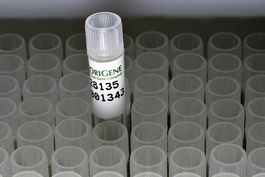FGFR2 (NM_001144919) Human Untagged Clone
CAT#: SC326169
FGFR2 (untagged)-Human fibroblast growth factor receptor 2 (FGFR2), transcript variant 9
"NM_001144919" in other vectors (4)
Product Images

Specifications
| Product Data | |
| Type | Human Untagged Clone |
| Tag | Tag Free |
| Symbol | FGFR2 |
| Synonyms | BBDS; BEK; BFR-1; CD332; CEK3; CFD1; ECT1; JWS; K-SAM; KGFR; TK14; TK25 |
| Vector | pCMV6-Entry |
| E. coli Selection | Kanamycin (25 ug/mL) |
| Mammalian Cell Selection | Neomycin |
| Sequence Data |
>NCBI ORF sequence for NM_001144919, the custom clone sequence may differ by one or more nucleotides
ATGGTCAGCTGGGGTCGTTTCATCTGCCTGGTCGTGGTCACCATGGCAACCTTGTCCCTGGCCCGGCCCT CCTTCAGTTTAGTTGAGGATACCACATTAGAGCCAGAAGATGCCATCTCATCCGGAGATGATGAGGATGA CACCGATGGTGCGGAAGATTTTGTCAGTGAGAACAGTAACAACAAGAGAGCACCATACTGGACCAACACA GAAAAGATGGAAAAGCGGCTCCATGCTGTGCCTGCGGCCAACACTGTCAAGTTTCGCTGCCCAGCCGGGG GGAACCCAATGCCAACCATGCGGTGGCTGAAAAACGGGAAGGAGTTTAAGCAGGAGCATCGCATTGGAGG CTACAAGGTACGAAACCAGCACTGGAGCCTCATTATGGAAAGTGTGGTCCCATCTGACAAGGGAAATTAT ACCTGTGTAGTGGAGAATGAATACGGGTCCATCAATCACACGTACCACCTGGATGTTGTGGAGCGATCGC CTCACCGGCCCATCCTCCAAGCCGGACTGCCGGCAAATGCCTCCACAGTGGTCGGAGGAGACGTAGAGTT TGTCTGCAAGGTTTACAGTGATGCCCAGCCCCACATCCAGTGGATCAAGCACGTGGAAAAGAACGGCAGT AAATACGGGCCCGACGGGCTGCCCTACCTCAAGGTTCTCAAGCACTCGGGGATAAATAGTTCCAATGCAG AAGTGCTGGCTCTGTTCAATGTGACCGAGGCGGATGCTGGGGAATATATATGTAAGGTCTCCAATTATAT AGGGCAGGCCAACCAGTCTGCCTGGCTCACTGTCCTGCCAAAACAGCAAGCGCCTGGAAGAGAAAAGGAG ATTACAGCTTCCCCAGACTACCTGGAGATAGCCATTTACTGCATAGGGGTCTTCTTAATCGCCTGTATGG TGGTAACAGTCATCCTGTGCCGAATGAAGAACACGACCAAGAAGCCAGACTTCAGCAGCCAGCCGGCTGT GCACAAGCTGACCAAACGTATCCCCCTGCGGAGACAGGTAACAGTTTCGGCTGAGTCCAGCTCCTCCATG AACTCCAACACCCCGCTGGTGAGGATAACAACACGCCTCTCTTCAACGGCAGACACCCCCATGCTGGCAG GGGTCTCCGAGTATGAACTTCCAGAGGACCCAAAATGGGAGTTTCCAAGAGATAAGCTGACACTGGGCAA GCCCCTGGGAGAAGGTTGCTTTGGGCAAGTGGTCATGGCGGAAGCAGTGGGAATTGACAAAGACAAGCCC AAGGAGGCGGTCACCGTGGCCGTGAAGATGTTGAAAGATGATGCCACAGAGAAAGACCTTTCTGATCTGG TGTCAGAGATGGAGATGATGAAGATGATTGGGAAACACAAGAATATCATAAATCTTCTTGGAGCCTGCAC ACAGGATGGGCCTCTCTATGTCATAGTTGAGTATGCCTCTAAAGGCAACCTCCGAGAATACCTCCGAGCC CGGAGGCCACCCGGGATGGAGTACTCCTATGACATTAACCGTGTTCCTGAGGAGCAGATGACCTTCAAGG ACTTGGTGTCATGCACCTACCAGCTGGCCAGAGGCATGGAGTACTTGGCTTCCCAAAAATGTATTCATCG AGATTTAGCAGCCAGAAATGTTTTGGTAACAGAAAACAATGTGATGAAAATAGCAGACTTTGGACTCGCC AGAGATATCAACAATATAGACTATTACAAAAAGACCACCAATGGGCGGCTTCCAGTCAAGTGGATGGCTC CAGAAGCCCTGTTTGATAGAGTATACACTCATCAGAGTGATGTCTGGTCCTTCGGGGTGTTAATGTGGGA GATCTTCACTTTAGGGGGCTCGCCCTACCCAGGGATTCCCGTGGAGGAACTTTTTAAGCTGCTGAAGGAA GGACACAGAATGGATAAGCCAGCCAACTGCACCAACGAACTGTACATGATGATGAGGGACTGTTGGCATG CAGTGCCCTCCCAGAGACCAACGTTCAAGCAGTTGGTAGAAGACTTGGATCGAATTCTCACTCTCACAAC CAATGAGATCTGA |
| Restriction Sites | AscI-MluI |
| ACCN | NM_001144919 |
| OTI Disclaimer | Our molecular clone sequence data has been matched to the reference identifier above as a point of reference. Note that the complete sequence of our molecular clones may differ from the sequence published for this corresponding reference, e.g., by representing an alternative RNA splicing form or single nucleotide polymorphism (SNP). |
| OTI Annotation | This TrueClone is provided through our Custom Cloning Process that includes sub-cloning into OriGene's pCMV6 vector and full sequencing to provide a non-variant match to the expected reference without frameshifts, and is delivered as lyophilized plasmid DNA. |
| Product Components | The cDNA clone is shipped in a 2-D bar-coded Matrix tube as dried plasmid DNA. The package also includes 100 pmols of both the corresponding 5' and 3' vector primers in separate vials. Every lot of primer is tested to provide clean sequencing of OriGene TrueClones. |
| Reconstitution | 1. Centrifuge at 5,000xg for 5min. 2. Carefully open the tube and add 100ul of sterile water to dissolve the DNA. 3. Close the tube and incubate for 10 minutes at room temperature. 4. Briefly vortex the tube and then do a quick spin (less than 5000xg) to concentrate the liquid at the bottom. 5. Store the suspended plasmid at -20°C. The DNA is stable for at least one year from date of shipping when stored at -20°C. |
| Reference Data | |
| RefSeq | NM_001144919.1, NP_001138391.1 |
| RefSeq Size | 3011 bp |
| RefSeq ORF | 2043 bp |
| Locus ID | 2263 |
| Cytogenetics | 10q26.13 |
| Protein Families | Druggable Genome, Protein Kinase, Secreted Protein, Transmembrane |
| Protein Pathways | Endocytosis, MAPK signaling pathway, Pathways in cancer, Prostate cancer, Regulation of actin cytoskeleton |
| Gene Summary | 'The protein encoded by this gene is a member of the fibroblast growth factor receptor family, where amino acid sequence is highly conserved between members and throughout evolution. FGFR family members differ from one another in their ligand affinities and tissue distribution. A full-length representative protein consists of an extracellular region, composed of three immunoglobulin-like domains, a single hydrophobic membrane-spanning segment and a cytoplasmic tyrosine kinase domain. The extracellular portion of the protein interacts with fibroblast growth factors, setting in motion a cascade of downstream signals, ultimately influencing mitogenesis and differentiation. This particular family member is a high-affinity receptor for acidic, basic and/or keratinocyte growth factor, depending on the isoform. Mutations in this gene are associated with Crouzon syndrome, Pfeiffer syndrome, Craniosynostosis, Apert syndrome, Jackson-Weiss syndrome, Beare-Stevenson cutis gyrata syndrome, Saethre-Chotzen syndrome, and syndromic craniosynostosis. Multiple alternatively spliced transcript variants encoding different isoforms have been noted for this gene. [provided by RefSeq, Jan 2009]' Transcript Variant: This variant (9) is missing an in-frame coding exon, uses an alternate internal in-frame coding exon (as in variant 2) and an alternate 3' terminal exon, compared to transcript variant 1. This results in a shorter isoform (9), which differs in two internal segments, and has a novel C-terminus compared to isoform 1. Sequence Note: This RefSeq record was created from transcript and genomic sequence data because no quality transcript was available for the full length of the gene. The extent of this transcript is supported by transcript alignments. A downstream AUG translation start codon is selected for this RefSeq based on the presence of a strong Kozak consensus signal, a strong community standard for the use of the downstream start codon, and on a higher probability of an N-terminal signal peptide being present in the resulting protein. The use of an alternative in-frame upstream AUG start codon would result in a protein that is 19 aa longer at the N-terminus. Translation from the annotated downstream start codon is likely to occur via leaky scanning and/or reinitiation. |
Documents
| Product Manuals |
| FAQs |
Resources
Other Versions
| SKU | Description | Size | Price |
|---|---|---|---|
| RC227485 | FGFR2 (Myc-DDK-tagged)-Human fibroblast growth factor receptor 2 (FGFR2), transcript variant 9 |
USD 760.00 |
|
| RG227485 | FGFR2 (GFP-tagged) - Human fibroblast growth factor receptor 2 (FGFR2), transcript variant 9 |
USD 840.00 |
|
| RC227485L3 | Lenti ORF clone of Human fibroblast growth factor receptor 2 (FGFR2), transcript variant 9, Myc-DDK-tagged |
USD 960.00 |
|
| RC227485L4 | Lenti ORF clone of Human fibroblast growth factor receptor 2 (FGFR2), transcript variant 9, mGFP tagged |
USD 960.00 |
{0} Product Review(s)
Be the first one to submit a review






























































































































































































































































 Germany
Germany
 Japan
Japan
 United Kingdom
United Kingdom
 China
China
